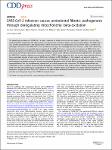SARS-CoV-2 infection causes periodontal fibrotic pathogenesis through deregulating mitochondrial beta-oxidation
| dc.contributor.author | Gao, Y | |
| dc.contributor.author | Kok, WL | |
| dc.contributor.author | Sharma, V | |
| dc.contributor.author | Illsley, CS | |
| dc.contributor.author | Hanks, S | |
| dc.contributor.author | Tredwin, C | |
| dc.contributor.author | Hu, B | |
| dc.date.accessioned | 2023-08-09T13:28:40Z | |
| dc.date.available | 2023-08-09T13:28:40Z | |
| dc.date.issued | 2023 | |
| dc.identifier.issn | 2058-7716 | |
| dc.identifier.issn | 2058-7716 | |
| dc.identifier.other | 175 | |
| dc.identifier.uri | https://pearl.plymouth.ac.uk/handle/10026.1/21192 | |
| dc.description.abstract |
The global high prevalence of COVID-19 is a major challenge for health professionals and patients. SARS-CoV-2 virus has four structural protein components: the spike protein, envelope protein, membrane protein, and nucleocapsid protein. The SARS-CoV-2 virus mutates predominantly in the spike proteins, whilst the other key viral components usually remain stable. Essentially the pathological functions of the SARS-CoV-2 virus on different cell types are still largely unknown. Previous studies have shown that the human oral cavity can potentially act as reservoir of the SARS-CoV-2 virus. However, the consequence of SARS-CoV-2 viral infection on human oral health has not been systematically examined. COVID-19 can cause severe oral mucosa lesions and is likely to be connected with poor periodontal conditions. Fibroblasts are the major cell type inside periodontal ligament (PDL) and express the SARS-CoV-2 receptor: Angiotensin-converting enzyme 2 (ACE2), whose expression level can increase upon bacterial infection hence potentially provide a direct route of SARS-CoV-2 infection to PDL fibroblasts. In this research, we aimed to study the pathogenicity of SARS-CoV-2 viral components on human fibroblasts. We found that by exposing to SARS-CoV-2, especially to the viral envelope and membrane proteins, the human periodontal fibroblasts could develop fibrotic pathogenic phenotypes, including hyperproliferation that was simultaneously induced with increased apoptosis and senescence. The fibrotic degeneration was mediated by a down-regulation of mitochondrial β-oxidation in the fibroblasts. Fatty acid β-oxidation inhibitor, etomoxir treatment could mirror the same pathological consequence on the cells, similar to SARS-CoV-2 infection. Our results therefore provide novel mechanistic insights into how SARS-CoV-2 infection can affect human periodontal health at the cell and molecular level with potential new therapeutic targets for COVID-19 induced fibrosis. | |
| dc.format.extent | 175- | |
| dc.format.medium | Electronic | |
| dc.language | en | |
| dc.publisher | Springer Science and Business Media LLC | |
| dc.subject | 31 Biological Sciences | |
| dc.subject | 3102 Bioinformatics and Computational Biology | |
| dc.subject | 32 Biomedical and Clinical Sciences | |
| dc.subject | 3203 Dentistry | |
| dc.subject | Dental/Oral and Craniofacial Disease | |
| dc.subject | Prevention | |
| dc.subject | Lung | |
| dc.subject | Emerging Infectious Diseases | |
| dc.subject | Infectious Diseases | |
| dc.subject | Pneumonia | |
| dc.subject | 2.2 Factors relating to the physical environment | |
| dc.subject | 2 Aetiology | |
| dc.subject | 2.1 Biological and endogenous factors | |
| dc.subject | Infection | |
| dc.subject | 3 Good Health and Well Being | |
| dc.title | SARS-CoV-2 infection causes periodontal fibrotic pathogenesis through deregulating mitochondrial beta-oxidation | |
| dc.type | journal-article | |
| dc.type | Article | |
| plymouth.author-url | https://www.ncbi.nlm.nih.gov/pubmed/37236979 | |
| plymouth.issue | 1 | |
| plymouth.volume | 9 | |
| plymouth.publisher-url | http://dx.doi.org/10.1038/s41420-023-01474-2 | |
| plymouth.publication-status | Published online | |
| plymouth.journal | Cell Death Discovery | |
| dc.identifier.doi | 10.1038/s41420-023-01474-2 | |
| plymouth.organisational-group | |Plymouth | |
| plymouth.organisational-group | |Plymouth|Research Groups | |
| plymouth.organisational-group | |Plymouth|Faculty of Health | |
| plymouth.organisational-group | |Plymouth|Research Groups|Institute of Translational and Stratified Medicine (ITSMED) | |
| plymouth.organisational-group | |Plymouth|Research Groups|Institute of Translational and Stratified Medicine (ITSMED)|CBR | |
| plymouth.organisational-group | |Plymouth|REF 2021 Researchers by UoA | |
| plymouth.organisational-group | |Plymouth|Users by role | |
| plymouth.organisational-group | |Plymouth|Users by role|Academics | |
| plymouth.organisational-group | |Plymouth|REF 2021 Researchers by UoA|UoA01 Clinical Medicine | |
| plymouth.organisational-group | |Plymouth|REF 2021 Researchers by UoA|UoA03 Allied Health Professions, Dentistry, Nursing and Pharmacy | |
| plymouth.organisational-group | |Plymouth|Faculty of Health|Peninsula Dental School | |
| plymouth.organisational-group | |Plymouth|Faculty of Health|School of Biomedical Sciences | |
| plymouth.organisational-group | |Plymouth|Users by role|Researchers in ResearchFish submission | |
| dc.publisher.place | United States | |
| dcterms.dateAccepted | 2023-05-16 | |
| dc.date.updated | 2023-08-09T13:28:32Z | |
| dc.rights.embargodate | 2023-8-10 | |
| dc.identifier.eissn | 2058-7716 | |
| dc.rights.embargoperiod | forever | |
| rioxxterms.versionofrecord | 10.1038/s41420-023-01474-2 |


